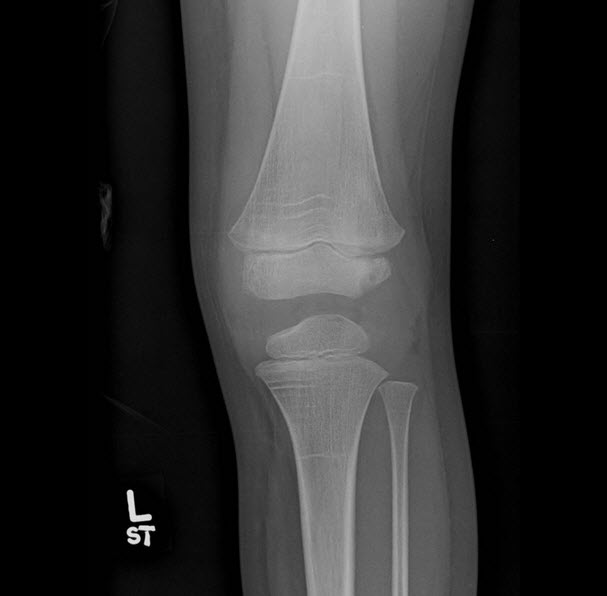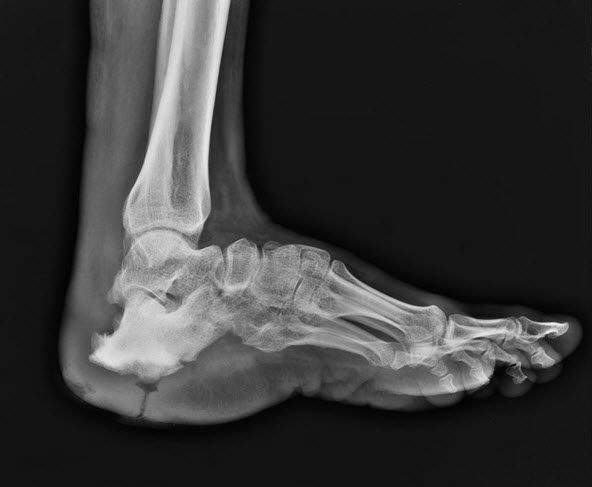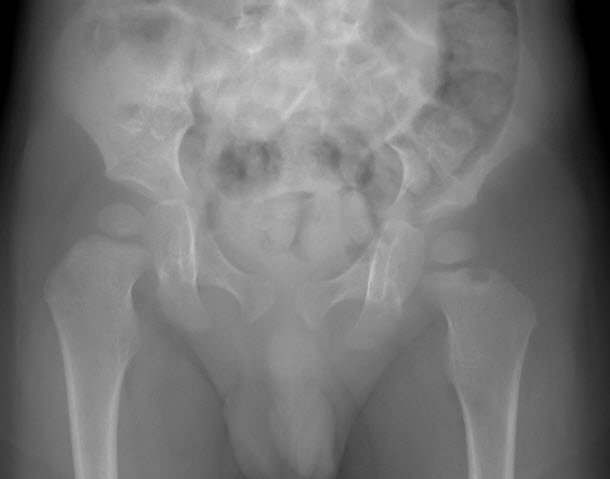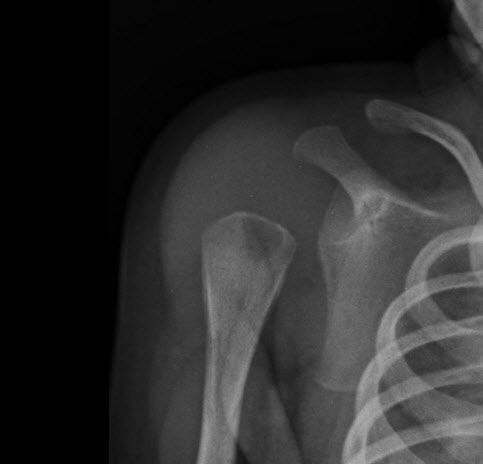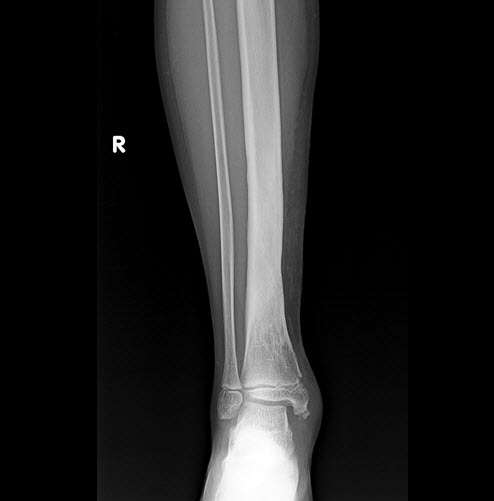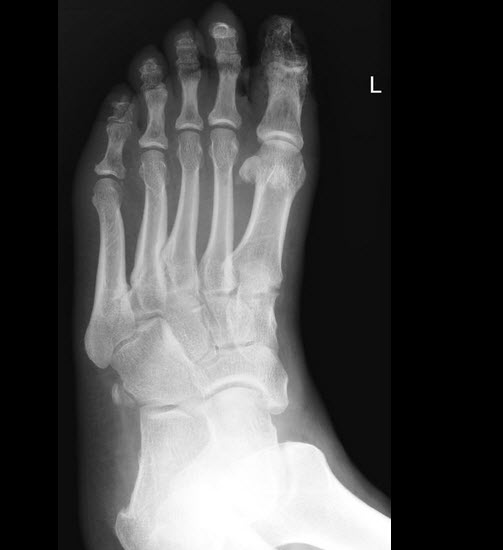Osteomyelitis x ray: Difference between revisions
No edit summary |
mNo edit summary |
||
| Line 1: | Line 1: | ||
__NOTOC__ | __NOTOC__ | ||
{{Osteomyelitis}} | {{Osteomyelitis}} | ||
{{CMG}};{{AE}}{{MehdiP}} | {{CMG}}; {{AE}}{{MehdiP}} | ||
==Overview== | ==Overview== | ||
Diagnosis of osteomyelitis is often based on [[radiology|radiologic]] results | Diagnosis of osteomyelitis is often based on [[radiology|radiologic]] results which demonstrate a [[lytic]] center with a ring of [[sclerosis]], though bone cultures are normally required to identify the specific pathogen. Conventional radiographic evaluation of acute osteomyelitis is insufficient because bone changes are not evident for 14–21 days after the onset of [[infection]]. | ||
==X | |||
==X Ray== | |||
*Because conventional radiography is readily available, relatively inexpensive, and useful in differentiation of infection from trauma and tumors, it remains the initial imaging test of choice for suspected osteomyelitis. | *Because conventional radiography is readily available, relatively inexpensive, and useful in differentiation of infection from trauma and tumors, it remains the initial imaging test of choice for suspected osteomyelitis. | ||
*In addition, plain radiography is often a helpful adjunct to secondary imaging studies. Unfortunately, radiographic evidence of osteomyelitis lags behind the clinical picture, and less than one third of patients have abnormalities on plain radiographs in the first 7 to 10 days after the onset of symptoms. | *In addition, plain radiography is often a helpful adjunct to secondary imaging studies. Unfortunately, radiographic evidence of osteomyelitis lags behind the clinical picture, and less than one third of patients have abnormalities on plain radiographs in the first 7 to 10 days after the onset of symptoms. | ||
| Line 11: | Line 12: | ||
*Other findings include, soft tissue edema and deep muscles displacement. | *Other findings include, soft tissue edema and deep muscles displacement. | ||
<gallery perRow="3"> | <gallery perRow="3"> | ||
image:om-1.jpg|Lucent lesion in the lateral aspect of the left distal femoral epiphysis and joint effusion. | image:om-1.jpg|Lucent lesion in the lateral aspect of the left distal [[femoral]] [[epiphysis]] and joint effusion. | ||
image:om-2.jpg|Air filled sinus tract | image:om-2.jpg|Air filled sinus tract which leads to to sclerosed, deformed calcaneum. | ||
image:om-3.jpg| | image:om-3.jpg|Lucency on the lateral margin of the metaphysis adjacent to the physis of head of left femor. | ||
image:om-4.jpg|Proximal humeral metaphyseal lytic focus in a 25 days neonate. | image:om-4.jpg|Proximal humeral metaphyseal lytic focus in a 25 days neonate. | ||
image:om-5.jpg|Sclerosis of the distal tibial diaphysis associated with bone expansion and soft tissue thickening. | image:om-5.jpg|[[Sclerosis]] of the distal tibial [[diaphysis]] associated with bone expansion and soft tissue thickening. | ||
image:om-6.jpg| | image:om-6.jpg|Loss of soft tissue over the great toe, with further lucencies in the surrounding soft tissue associated patchy osteoporosis in underlying phalanx in a diabetic foot patient | ||
</gallery> | </gallery> | ||
==References== | ==References== | ||
{{Reflist|2}} | {{Reflist|2}} | ||
[[Category:Orthopedics]] | [[Category:Orthopedics]] | ||
[[Category:Infectious disease]] | [[Category:Infectious disease]] | ||
Revision as of 13:21, 21 February 2017
|
Osteomyelitis Microchapters |
|
Diagnosis |
|---|
|
Treatment |
|
Case Studies |
|
Osteomyelitis x ray On the Web |
|
American Roentgen Ray Society Images of Osteomyelitis x ray |
Editor-In-Chief: C. Michael Gibson, M.S., M.D. [1]; Associate Editor(s)-in-Chief: Seyedmahdi Pahlavani, M.D. [2]
Overview
Diagnosis of osteomyelitis is often based on radiologic results which demonstrate a lytic center with a ring of sclerosis, though bone cultures are normally required to identify the specific pathogen. Conventional radiographic evaluation of acute osteomyelitis is insufficient because bone changes are not evident for 14–21 days after the onset of infection.
X Ray
- Because conventional radiography is readily available, relatively inexpensive, and useful in differentiation of infection from trauma and tumors, it remains the initial imaging test of choice for suspected osteomyelitis.
- In addition, plain radiography is often a helpful adjunct to secondary imaging studies. Unfortunately, radiographic evidence of osteomyelitis lags behind the clinical picture, and less than one third of patients have abnormalities on plain radiographs in the first 7 to 10 days after the onset of symptoms.
- Radiologic finding suggestive for osteomyelitis is, a lytic center with a ring of sclerosis.[1]
- Other findings include, soft tissue edema and deep muscles displacement.
-
Air filled sinus tract which leads to to sclerosed, deformed calcaneum.
-
Lucency on the lateral margin of the metaphysis adjacent to the physis of head of left femor.
-
Proximal humeral metaphyseal lytic focus in a 25 days neonate.
-
Loss of soft tissue over the great toe, with further lucencies in the surrounding soft tissue associated patchy osteoporosis in underlying phalanx in a diabetic foot patient
References
- ↑ Pineda C, Vargas A, Rodríguez AV (2006). "Imaging of osteomyelitis: current concepts". Infect. Dis. Clin. North Am. 20 (4): 789–825. doi:10.1016/j.idc.2006.09.009. PMID 17118291.
